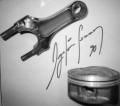I think the pump, is activiated purely on lack of pressure in the 'pre-charge' system of the ABS. The is a tank which stores ABS fluid under pressure. A pressure switch will sense a low pressure and the pump recharges it. If the pressure is not brought up to normal within 30secs then the warning light will show. Braking hard enough to engage the ABS a couple of times, or even once for a few seconds will get the pump going.
Something I wanted to do is upgrade to the latest ABS unit. I would do that over any repairs to the current system.




 Reply With Quote
Reply With Quote

